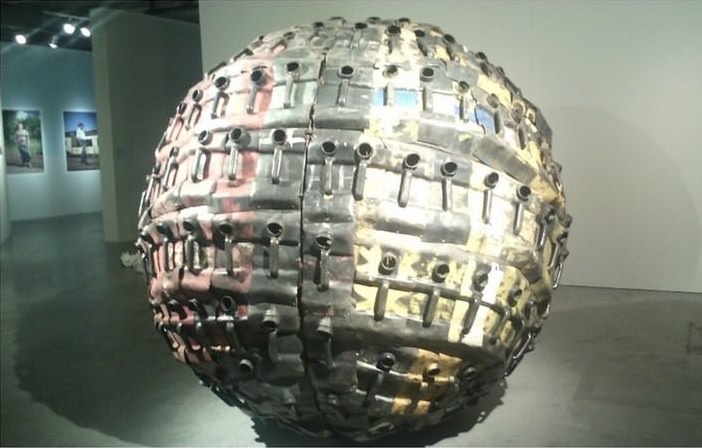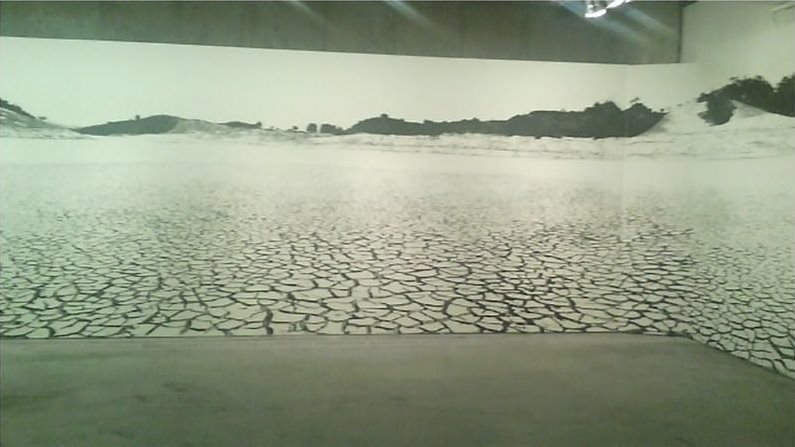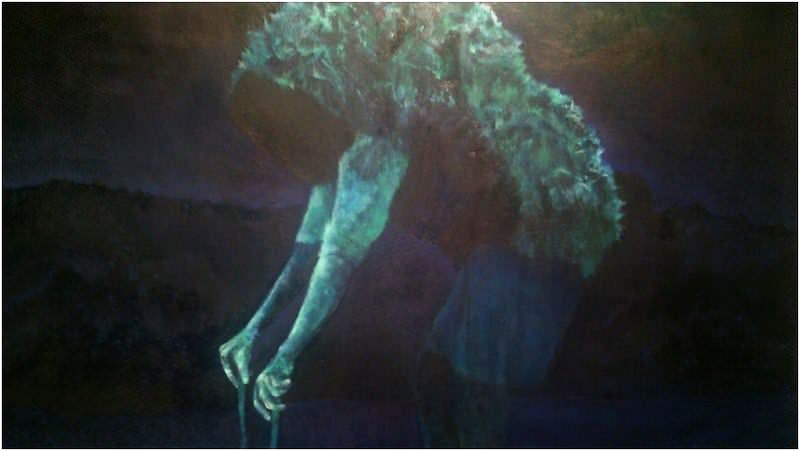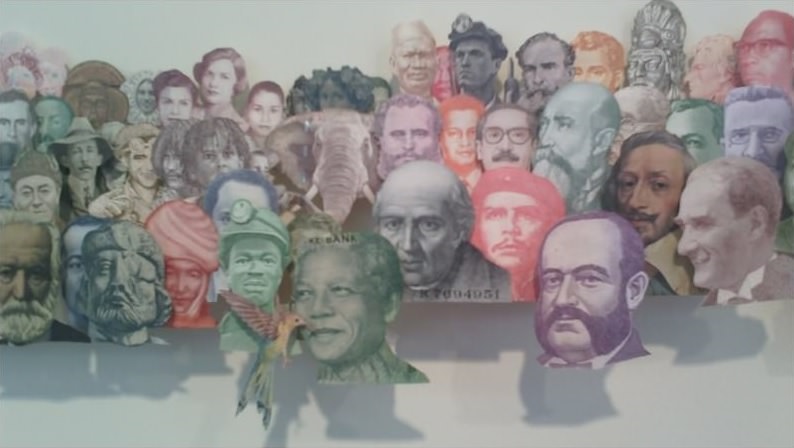
The Contemporary
Frestas – Trienal de Artes
Exhibition “What would the world be without the things that do not exist?” – Sesc Sorocaba
by Rosângela Vig
.
The Artist is, certainly, the son of his time, but woe to him if also his disciple or even your favorite. (SCHILLER, 2002, p.50)
Perhaps this is the best phrase to explain the art that is presented in Contemporary. Schiller lived in the second half of the eighteenth century and expressed his thoughts about education through Aesthetic. In the words above, the philosopher makes clear the idea that art should take its course, its time and the thought of the time in which it operates. In this light, it emerges from the hand of the artist “the world”, proposing new knowledge, new questions and can awaken the viewer to new. More than the incantation, the work, accordingly raises reasoning, as a game, the Game of Art. And Contemporary Art shows that side by a constant metamorphosis, as it is society itself.

The Conceptual Art entered this contemporary arts as a way of asking, to question and to unsettle. The term Conceptual Art was first mentioned in 1961, by the philosopher Henry Flynt and, later, Sol Lewitt coined the term Conceptual Art, in an article for the Journal Artforum. This new Art form in which it is allowed to include and encourage debates, paved the way for much of what is presented in Art today, as the installations, the performances, interventions, videos and audios.
Uncoupled the accuracy of the form, leaning on his idea, the artist allowed to flow freely the idea for the material that he had. The aesthetic freedom again refers to the thought of Schiller (2002, p.21), when mentions that the Art “is the daughter of freedom and want to be legislated by the laws of the spirit, not by the deprivation of matter”. The artistic object of this format, perhaps not as linked to the issue of Beautiful or Sublime, led the artist to “do” free, without concern with paterns, but with an insight about the representation of your idea.

Governed by this thought, the artists of Trienal de Artes, present at Sesc de Sorocaba, until the month of February 2015, a show with installations, videos, audios, paintings, photographs and sculptures. The presented works raise that look to the contemporary, raise questions about the society, their problems and, more than that, promote a possibility of new dialogues, through the art object. The phrase, “Our proposition is the dialogue”, at the entrance of the event's main lobby, makes it clear that goal.
Among the proposed topics, are the passage of the human being for the planet, his dirt trail, degradation and pollution; the issue of water; religion; among other controversial and debatable points. In the midst of all this, is allowed involvement of the viewer, that attaches to the work, as part of it and part of the problem. It is possible to touch, interact, perceive and feel completely Art.

At the age of ancient Greeks, perhaps a show like this would cause astonishment, in the category of beauty, to the contemporary answer to the question of taste, in Art. But today's artist could still add that freedom of Contemporary Art allows especially, building something that is closer to representation of your idea, even if it is not based on pre-established mold beauty or reality. The role of this Art is not as, the destruction of traditional values, but is to highlight the importance of the idea and the creative spirit of the artist in his way of interpreting the world. And one can't help but remember that, even for Plato (2004, p.87), figurative Art was seen as an interpretation of reality, represented how the artist saw things.
And above all the question of taste for art object is not linked to the representation of a dimension related to reality and the proportions, but a reflective judgment that acts on individual strengths. This search for what pleases the senses was taking shape over time, in the form of periods and changing aspects. The artistic work is, in this way, attached to an idea of filing aiming to produce intense aesthetic experiences.
E to finish,
“Who would dare to give the Arts, the sterile function of imitating nature?” (BAUDELAIRE, 2007, p.65).
Testimony of Consecrated Actor Paulo Betti about Frestas, Trienal de Artes:
Photo of the Exhibition:
Credit photos: Rosângela Vig. Work of Malu Saddi, credit website Sesc.
Check also:
- Official Website Frestas, Trienal de Artes: frestas.sescsp.org.br
- Fan Page of Trienal de Artes in Facebook: www.facebook.com/frestas.trienal.artes
Our thanks to Sesc Sorocaba, and as it is presented in its site, follows:
“THE TRIENAL – Conceived by the Sesc Sorocaba team and head curator of Josué Mattos, Frestas – Trienal de Artes is a transdisciplinary project focusing on the visual arts with three different exhibition centers and will feature theater shows, musical performances and performances, that will take place between 23 October and 3 May 2015.
The Trienal is in response to an aspiration of the Sesc Sorocaba team reshape the Terra Rasgada, conducted by the institution in the decade of 1990. In partnership with the Ministry of Culture and the Municipality, the Terra Rasgada had great impact to Sorocaba public as to the city's artists. From this local experience, the city extends its look out: Frestas intends to create space for other forms, meanings and dimensions for the visual arts in Sorocaba.
In addition to developing educational processes to generate public interest, encourage local artistic production, procedural and permanent and present works by artists who never exhibited in Brazil, the Trienal central interest is to get together artists from different parts of the world in Sorocaba, in a movement of decentralization of contemporary art centers.”
Visual Artists:
[one_third]
- Adela Jussic
- Adrian Melis
- Afonso Tostes
- Amilcar Packer
- Ana Gallardo
- Ana Tomimori
- Andrés Aizicovich
- Anton Steenbock
- Barbara Wagner
- Bayrol Jimenez
- Bil Luhmann
- Bjorn Eric Haugen
- Brigida Baltar
- Bruno Kurru
- Bruno Moreschi
- Cristina Garrido
- Bruno Vilela
- Caetano Dias
- Cao Guimarães
- Lucas Bombozzi
- Beto Magalhães
[/one_third][one_third]
Sign up to receive Event News
and the Universe of Arts first!
- Carlos Castro
- Carlos Motta
- Daniel Santiago
- Dionisio González
- Emmanuel Lagarrigue
- Evandro Machado
- Faycal Baghriche
- Felippe Moraes
- Fernando Arias
- Irmãos Guimarães
- James Webb
- Joana Corona
- Jonas Arrabal
- Julia Kater
- Kauê Garcia
- Kristina Norman
- Laura Belem
- Leonora de Barros
- Luisa Nobrega
- Lume
- Malu Saddi
[/one_third][one_third_last]
- Marcela Armas
- Marcelo Moscheta
- Maya Watanabe
- Neha Choksi
- Nuria Guell
- Priscila Fernandes
- Raquel Stolf
- Regina Parra
- Rithy Panh
- Rochelle Costi
- Rodrigo Torres
- Romuald Hazoume
- Sandra Cinto
- Société Réaliste
- Tamara Kuselman
- Valérie Mréjen
- Vasco Araújo
- Veronica Stigger
- Véio
- Victor Leguy
- Waléria Américo
[/one_third_last]
…
Liked? [highlight]Leave a comment[/highlight]!
References:
BAUDELAIRE, Charles. Sobre a Modernidade, 6to. ed., São Paulo, Editora Paz e Terra, 2007
BAYER, Raymond. História da Estética. Lisboa: Editorial Estampa, 1993. Tradução de José Saramago.
DUROZOI, Gérard; ROUSSEL, André. Dicionário de Filosofia. 3to. Edition. Campinas: Papirus, 1999.
FARTHING, Stephen. Tudo Sobre a Arte. Rio de Janeiro: Sextante, 2011.
GOMBRICH, E.H. A História da Arte. Rio de Janeiro: Editora Guanabara, 1988.
PLATO. A República. São Paulo: Nova Cultural, 2004.
SCHILLER, Friedrich Von. A Educação Estética do homem. 4to. edição. S.Paulo: Ed. Iluminuras, 2002
ROSÂNGELA VIG
Sorocaba – São Paulo
Facebook Profile | Facebook Fan Page | Website
Columnist at Website Obras de Arte
E-mail: rosangelavig@hotmail.com












The Contemporary, Frestas – Trienal de Artes, Sesc Sorocaba by Rosângela Vig | Website Obras de Arte http://t.co/sdhpxl6ixK #art
The Contemporary, Frestas – Trienal de Artes, Sesc Sorocaba by Rosângela Vig | Website Obras de Arte http://t.co/7ehnTOmtJe
Staffsescsorocaba SESC, India, Thanks for the support! http://t.co/sdhpxl6ixK ##artesvisuais #frestas art
The Contemporary, Frestas – Trienal de Artes, Sesc Sorocaba by Rosângela Vig http://t.co/iA8lpPzyq1
Frestas – Trienal de Artes . Are contemporary
What would the world be without the things that do not exist… http://t.co/ZpLkBVpsnL
My new article on the Contemporary Art at the Art Works site
Frestas exposure – Trienal de Artes… http://t.co/krum38Qjm4
Frestas – Triennial of Contemporary Art Arts… http://t.co/wxhf3ewWU7
Frestas – Triennale Arts SESC Sorocaba… http://t.co/XOleZNy05f
Frestas – Arts Triennialsescsorocaba http://t.co/pircylaWXE
The Contemporary, Frestas – Trienal de Artes, Sesc Sorocaba by Rosângela Vig http://t.co/pmotoYnePu
The Contemporary, Frestas – Trienal de Artes, Sesc Sorocaba by Rosângela Vig http://t.co/pircylaWXE
The Contemporary, Frestas – Trienal de Artes, Sesc Sorocaba by Rosângela Vig http://t.co/pircykTlPA